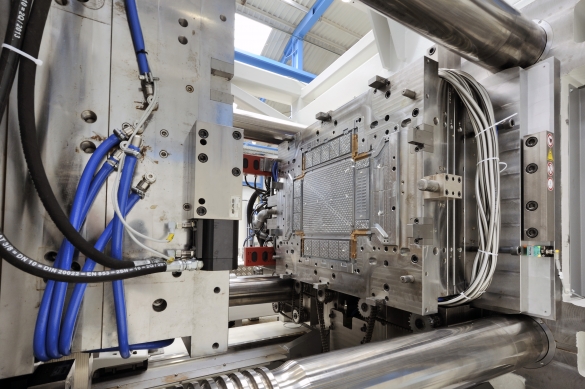Everything about Die Castings
Wiki Article
Little Known Facts About Lean Manufacturing.
Table of ContentsManufacturing for BeginnersSome Of Die CastingThe smart Trick of Oem That Nobody is Talking AboutLean Manufacturing Things To Know Before You Get ThisManufacturing Can Be Fun For AnyoneGetting The Mfg To Work
The text on this page is a sample from our complete White Paper 'Injection Moulding for Buyers' - * Example text * - for full guide click the download button above! Introduction This overview is intended for people that are wanting to resource plastic mouldings. It offers a much required insight into all that is entailed with creating plastic parts, from the mould device needed to the moulding process itself.If you wish to discover even more, the guide covers kinds of mould tools, in addition to unique finishing procedures such as colours & plating. Words that are underlined can be discovered in the glossary in the appendix ... Component I: Moulding: The Basics The Advantages of Shot Moulding Plastic injection moulding is a very accurate procedure that uses a number of benefits over other plastic handling techniques.
Accuracy is perfect for really elaborate parts. You can hold this moulding in the hand of your hand as well as it has employers, ribs, steel inserts, side cores as well as holes, made with a sliding shut off feature in the mould tool.
The Main Principles Of Additive Manufacturing


All About Additive Manufacturing
from material feed & melting; material injection; cooling time cooling down ejection to the re-closing of the mould tool ready for the next cycleFollowing Draft angles - The walls of a moulded component need to be slightly tapered in the instructions in which the part is ejected from the mould device, to allow the component to be ejected quickly.Ejector stroke - The pushing out of ejector pins to expel the moulded part from the mould tool. Ejector stroke rate, length and also timing requires to be thoroughly regulated to avoid damage to the ejectors as well as mould device, however at the same time make the moulding cycle as brief as feasible.

Additive Manufacturing - Questions
Ribs - When a plastic part has thin wall surfaces, ribs are contributed to the style to make the slim wall surfaces more powerful Side cores - Side action which produces a feature on a moulded part, at an opposing angle to the typical opening direction of the mould tool. lean manufacturing. The side core needs to be able to withdraw as the plastic part can not be expelled or else.
Walls - The sides of a moulded part The message on this web page is an example from our complete White Paper 'Shot Moulding for Customers'.
Production procedure for producing parts by infusing liquified product into a mould, or mold and mildew Streamlined diagram of the process Injection moulding (U.S. spelling: injection molding) is a production process for producing parts by infusing liquified material right into a mould, or mold and mildew. Shot moulding can be executed with a host of products mostly consisting of metals (for which the process is called die-casting), glasses, elastomers, confections, as well as most generally thermoplastic and thermosetting polymers. Injection moulding is commonly utilized for producing a variety of components, from the smallest parts to whole body panels of vehicles. Breakthroughs in 3D printing technology, making use of photopolymers that do not thaw during the shot moulding of some lower-temperature thermoplastics, can be made use of for some straightforward shot moulds. Injection moulding makes use of a special-purpose maker that has three parts: the injection system, the mould and also the clamp.
Things about Plastic Manufacturing
Refine attributes [edit] Injection moulding utilizes a ram or screw-type bettor to force molten plastic or rubber material into a mould dental caries; this strengthens into a form that has satisfied the shape of the mould. It is most frequently used to refine both polycarbonate and thermosetting polymers, with the quantity use the previous being considerably higher.: 13 Thermoplastics prevail because of qualities that make them highly suitable for shot moulding, such as simplicity of recycling, flexibility for a wide array of applications,: 89 and also capability to soften and move on home heating.In several cavity moulds, each tooth cavity can be similar and develop the same components or can be unique and create numerous various geometries during a single cycle.
The screw provides the raw material onward, mixes and homogenises the thermal and also viscous circulations of the polymer, and lowers the called for heating time by mechanically shearing the product and also including a considerable digital manufacturing amount of frictional home heating to the polymer. The material feeds forward through a check shutoff and also collects at the front of the screw right into a quantity called a shot. When sufficient material has actually oem manufacturing collected, the material is required at high stress and speed into the component developing dental caries. The exact quantity of contraction is a feature of the resin being made use of, and can be reasonably foreseeable. To avoid spikes in stress, the process normally utilizes a transfer setting corresponding to a 9598% complete cavity where the screw changes from a continuous rate to a consistent pressure control.
Lean Manufacturing - Truths
When the screw gets to the transfer setting the packing stress is applied, which finishes mould filling as well as makes up for thermal shrinkage, which is rather high for thermoplastics about many other products. The packing stress is applied up until the entrance (tooth cavity entrance) solidifies. Because of its small size, eviction is generally the initial place to solidify through its whole thickness.: 16 Once the gateway solidifies, no even more material can go into the dental caries; accordingly, the screw reciprocates and gets material for the following cycle while the material glass suppliers within the mould cools down to make sure that it can be expelled as well as be dimensionally stable.Report this wiki page